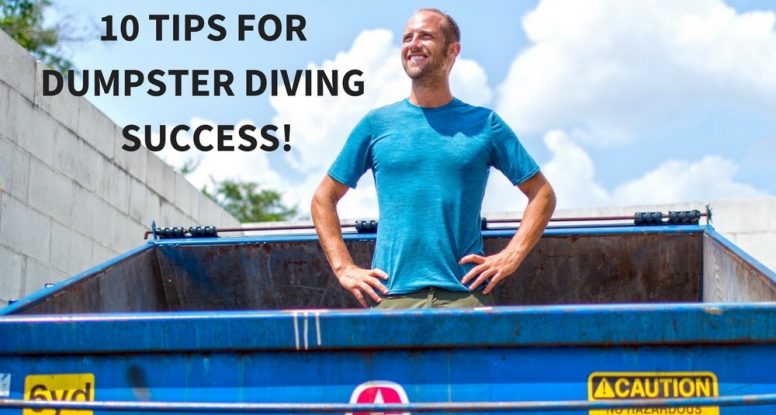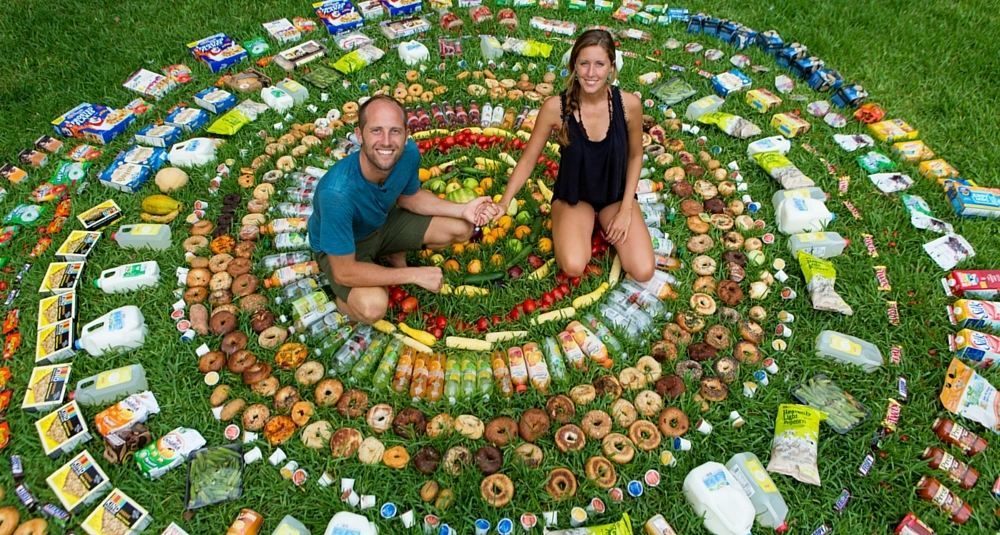
I’ve dived into over 2,000 dumpsters in over 25 states across the USA. By now I’ve pulled out tens of thousands of dollars worth of perfectly good food. Most of it I’ve given away but I’ve also lived solely off food from grocery store dumpsters for months at a time. My mission is to raise awareness about food waste and to reduce food waste and hunger in the USA. I don’t see dumpster diving as THE solution to food waste or hunger but at the same time I figure if the foods going to waste right now, why not eat it? Dumpster diving is not a global solution but for thousands of people it is an individual solution to reduce their environmental impact and feed themselves. So for those of you out there interested in saving a ton of money on food, reducing your environmental impact, or sharing a huge bounty of food with your friends and people in need I’m here to help with that. After 3 years of dumpster diving here are my top 10 tips to dumpster diving success.
- Play the numbers game. Going to a few dumpsters and then saying they are all locked or compactors is certain to end in failure. If you have a car move quickly between places if you don’t find anything. In 1.5 hours I can often go to about 10 dumpsters and by increasing the number of dumpsters you visit you are more likely to find success. If it is a compactor or its empty move onto the next but don’t go home. You can plan out a route on google maps prior to going out so that you know exactly where you are going and can stay organized and motivated. Don’t give up.
- Go to the source. You want to dive at the place that sells the food that you want. It is common sense but easy to forget the dumpsters are only going to have the same stuff that is sold inside the store. So for food you want to go to the places that sell a lot of food. This is mainly grocery stores, pharmacies, and farmers markets. Some really great stores can include: Trader Joes, Aldi, Food Lion, Big Lots, Smart & Final, CVS, Walgreens, and Rite Aid. Those are some of the chains that nationwide can be good. But don’t limit yourself to these by any means check the big chains and the local stores in your area and check them all.
- Get in and look around. I can’t tell you how many times I’ve looked into a dumpster to see nothing and then hopped in to realize there were 5 entire bags full of granola bars, cereal, and bread. Get in and move the bags around. A lot of the time food is all bagged up, often double bagged, fresh off the shelf and put straight into the dumpster. Other times you’ll move some bags or boxes around and find huge amounts of fresh fruits and vegetables either dumped in or in boxes. If you can’t get in due to physical reasons try to find a family member or friend that would go with you that can.
- Manage your fear. Don’t be running around all nervous and scared. Take your time, own up to what you are doing and have some confidence. I’ve spent an hour or more at a time in a dumpster. Make sure you don’t run from the dumpster out of fear and leave it full of the food you are after. It’s rare that anyone gets a ticket for dumpster diving, and arrests are basically non-existent as far as I can tell but I’ll cover you if you get a ticket or arrested anyway. The worst case scenario I’ve seen is a $200 minor trespassing ticket and if you can collect $1,000 worth of food in one night this ticket quickly would pay for itself. One way to reduce your fear is to do this for something greater than feeding yourself. Flip the stigma by becoming a food waste warrior and collect food to help others out. My guide has more advice on this.
- Bring the supplies you need and be prepared. By arriving at the dumpster prepared with everything you need you’ll feel more calm and be much quicker. Clean out your car and empty the trunk/ backseat so that you have plenty of space for the food you collect and you can set it right in without having to move stuff around. You can bring boxes or containers or you can just grab them out of the recycling bins or dumpsters of the store you are at. If you go at night a headlamp is definitely key. I suggest bringing some soap and water and a reusable towel to wash your hands. Wearing clothes that you don’t mind getting dirty will also make you more comfortable.
- Focus on middle and upper income areas. I’ve found that middle and upper income neighborhoods are where I have the best success. The very low income neighborhoods tend to have more locked dumpsters. If you live in a low income area with very few grocery stores it could be worth it to drive a half hour to a higher income area to dumpster dive. I once took some guys from South Side Chicago up to the Northern suburbs. It was a 40 minute drive but we collected $2,000 worth of food in the rich suburbs. There was no food to be found in their neighborhood of Englewood. Where there is a large population of homeless I tend to find more locked dumpsters. It does seem that where people are in more need the dumpsters are more often locked. This is just my experience so wherever you are I suggest giving it a try if you have the time but if you don’t have luck there it could be very worthy of traveling a little distance for success. Both tiny towns and big cities are great across the country.
- Go with a friend if you can. Having the support of another person can be really helpful but it’s also very practical. One person can be in the dumpster filling boxes while the other person can be taking them to a car. Sometimes one person will be in the dumpster handing stuff out to the person holding the lid up. It often makes it more enjoyable to be out with a friend or a group.
- Don’t let locks fool you. I’ve seen it dozens of times where I take someone out, they see a lock, and they start walking away. I walk over and see that the padlock is just resting there and the dumpster is not locked at all. Check to see if the dumpster is actually locked before assuming that it is. Beyond that, many locked dumpsters are still very easy to get inside. If the dumpster has a flimsy top you can often pull it over the bar and get inside for the goods. There’s been a lot of dumpsters that I’ve squeezed into and passed the food out box by box or pushed entire bags full of food out through the 1 or 2 foot gap. This is where partners definitely come in handy. And being physically fit is also helpful here. Some of you may not feel comfortable doing that and that’s ok. Another thing I see is that people assume because one store has a compactor or locked dumpster so will other nearby stores from the same chain. So if there’s a Publix with a compactor on Green St. it does not mean that the Publix on Brown St. a mile away will also have a compactor. As far as compactors go there isn’t many of those that you can get into. Those lock away the food and destine it for the landfill.
- Look around for compost bins and dumpsters. I can’t tell you how many grocery stores I’ve been to that have a compactor but also have a dumpster just around the corner. One way to fail at dumpster diving for food is to see a compactor or locked dumpster and then immediately give up. Take the time to look around a bit and see if there are other dumpsters that might have food in them. A lot of stores have food waste dumpsters where they dump just food that will ultimately be used for compost or animal feed. Many of these compost dumpsters I’ve found to be loaded with still fresh fruits and veggies. The point is be diligent and make sure you don’t miss the dumpster where they put the food.
- Come up with a route and schedule. After you’ve been doing this for a little while you’ll know which stores you should skip and which are worth your time. You’ll also start to create patterns so you know when the best times and days to go are. Combine this together and you’ll have an efficient route and schedule where you can hit all the places in as little time as it would have taken you to go grocery shopping.
People message me fairly often telling me that they went out dumpster diving for food and didn’t find any food at all. I often hear that all the dumpsters were locked or there were only compactors. I’m certain that most of the time if they really gave it their all and applied these tips that they would have had a successful dumpster diving outing. The reason why is that I’ve dumpster dived in at least 100 cities across the United States and have almost always had success. I’ve hosted 15 Food Waste Fiasco’s in Madison, Chicago, Cleveland, Detroit, Lancaster, Philadelphia, New York City, Burlington, San Diego, Los Angeles, Miami, Orlando, and Raleigh and every single one has been a massive success. Here is Orlando for example:

See the Food Waste Fiasco for more photos like this. I’ve also done dozens of dumpster diving stories with the news across the USA and I’ve found food for every single one of them. Because of this I have a very strong feeling that the food is out there for people who really put the effort into it. So these tips are to really help people overcome whatever boundaries they’ve had and start finding food and dumpster diving like a pro. For much more detail, tips, photos, and an in depth how-to give my Guide to Dumpster Diving a read.
Also to see what a successful dumpster diving outing looks like check out this video where I filled an empty pantry and fridge with over $1,000 worth of food in less than five hours of dumpster diving.
For a deeper look into food waste, detailed information on the problem and solutions, how to get involved, food rescue programs, dumpster diving, and more go to Rob’s Food Waste Activism and Dumpster Diving Resource Guide.








Reader Interactions